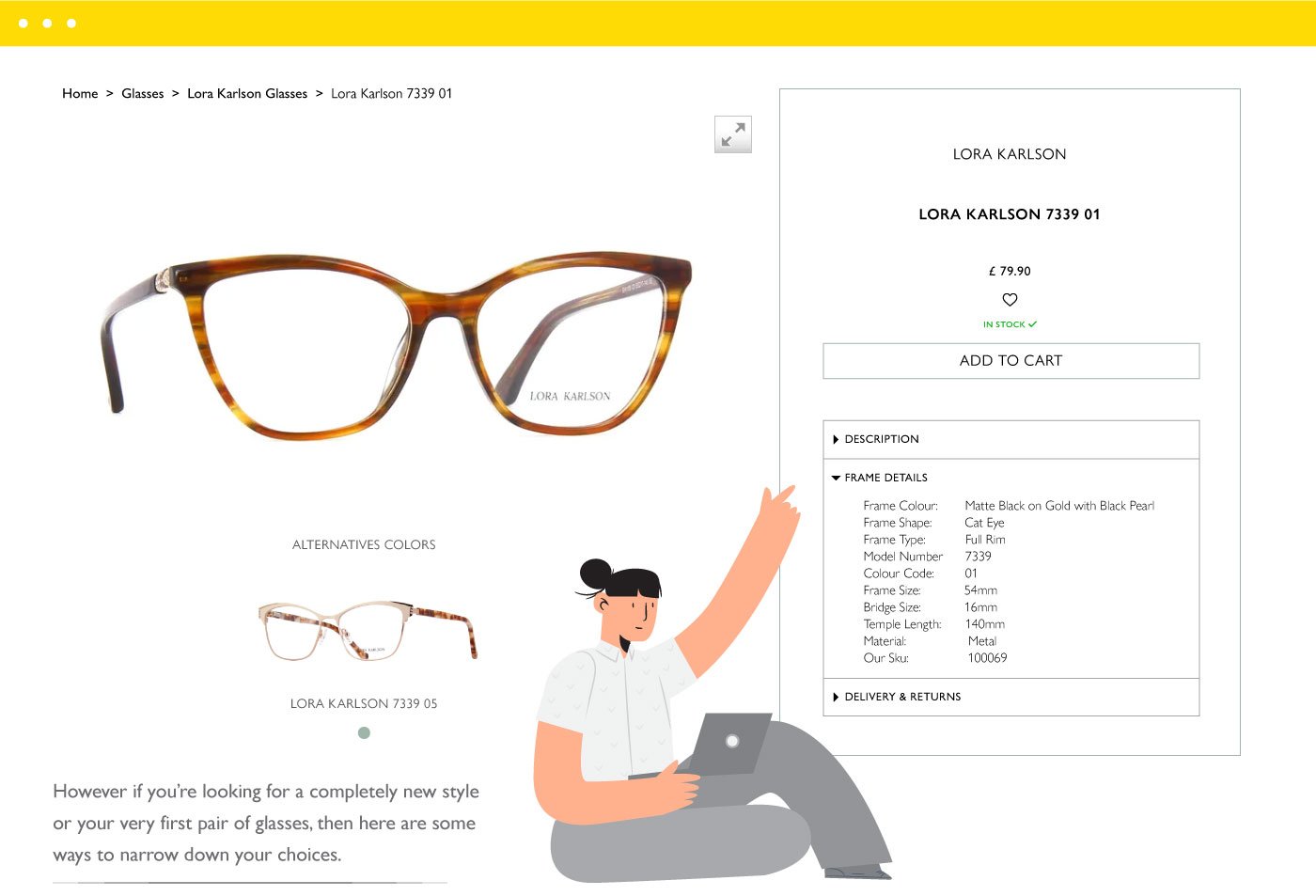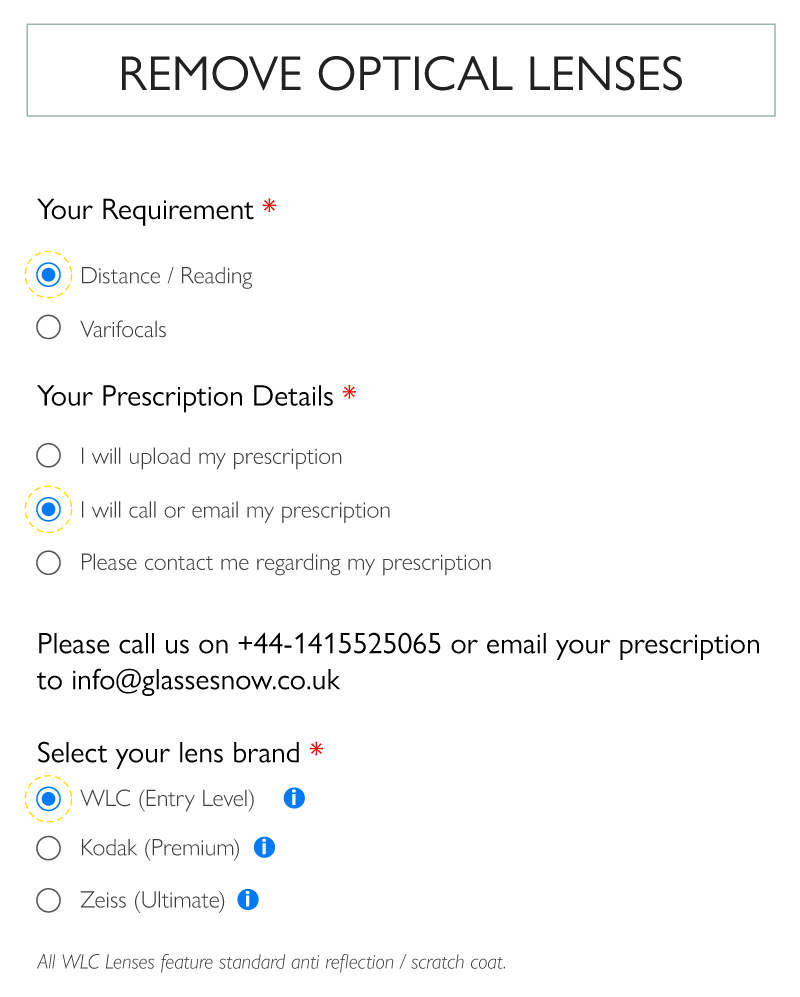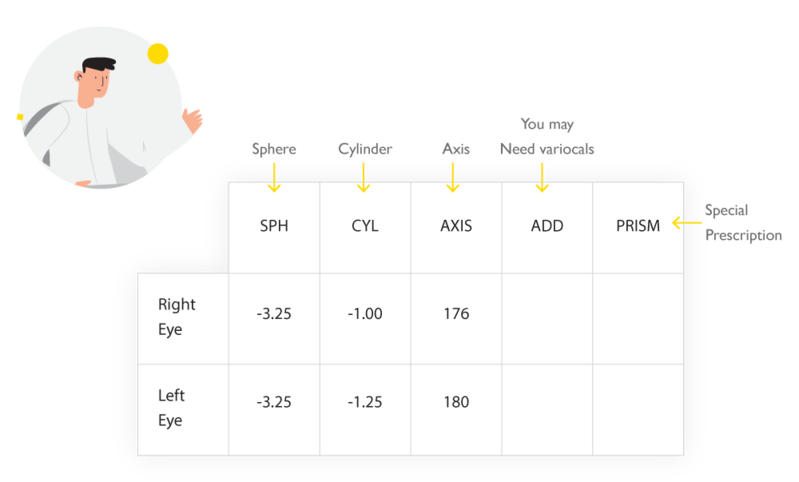Need to know a bit more?
Not a problem, our team are fully-trained to assist you...

When checking out with your glasses on GLASSESNOW you’ll see options to the right-hand side of your screen. Most commonly Add Optical Lenses or Buy Frame Only, to complete your purchase you need to choose one of these options.
Selecting the No Lenses option means you’ll receive the glasses with demo lenses which are temporary plastic lense fitted instead of optical lenses. These lenses often have brand logos emblazoned on the front - this will obscure your vision. We’d only recommend the No Lenses option if you plan to have your lenses glazed at another optician.

If you choose Add Optical Lenses you will be met with a few options


First off, you will need to let us know your requirements: Distance/Reading or Varifocals.
refers to lenses that assist you with seeing far. Sometimes this is referred to as ‘near sightedness’ or ‘myopia’, it is a common condition where you can see objects near to you clearly, but objects farther away are often distorted and blurry. Reading lenses, ‘far sightedness’ or ‘hyperopia’, is where you can see distant objects very clearly, but objects nearby may be clouded. Once you have selected this option you will be asked to upload your prescription, call or email us or have us contact you.

Sometimes known as ‘progressive lenses’, are an amalgamation of distance and reading. Providing multiple functions, the upper lens focuses on distance, and the lower assists you to focus close up . Together, they blend effortlessly in the centre which will allow you to focus on intermediate distances. When purchasing varifocal lenses, we require you to call us so we can discuss your requirements with our fully-trained opticians & dispensing team.


If you do not require prescription lenses but wish to buy glasses as a fashion accessory, you will still need to select Buy with Prescription, then I’ll enter my prescription manually - please choose ‘Plano/Infinity’ under sphere and make sure everything else is ‘0’ or ‘none’. PD can be left as ‘Average’

Once you have chosen your frame and if you do not require varifocal lenses, then please click the 'Buy with Prescription' button. You can then enter your prescription or, alternatively, you can select 'I Will Upload My Prescription' which allows you to select or take a photo on a mobile phone or tablet, or select an image from your computer. If you are still unsure you can select 'Please contact me regarding my prescription' and we will get in touch and talk you through it

If you are unsure how to read your prescription we’d suggest you select the ‘upload’ or ‘contact’ option and our fully-trained team will assist you. Most prescriptions usually look similar to this:

In the left column, you will see Right Eye and Left Eye: this can sometimes be referred to as OD for right, and OS for left
Then in the top row, you will see SPH, CYL, AXIS, AD and PRISM:
SPH means Sphere which is the main part of your prescription. The Sphere indicates the strength of your myopia (near sightedness) if it starts with a minus sign (–), or hyperopia (far sightedness) if preceded by a plus sign (+). If you see an infinity (∞) symbol or the letters, PL or Pl it means you are neither near sighted or far sighted.
CYL indicates the Cylinder. The cylinder will let the optician know if you have astigmatism. If the CYL column is empty or the letters DS or SPH are present, it means that you do not have astigmatism.
AXIS is only used when determining the location of your astigmatism. If your CYL column is empty, then do not insert anyvalue into the AXIS. On the other hand, if you do have a value inthe CYL column then you must have an AXIS value between 1 and 180 degrees. You should always insert a whole number (no decimal places).
ADD identifies if you require progressive lenses. If you have a number in this column then please return to your options and select ‘Varifocals’ and contact us.
PRISM is usually not applicable. If there is a value in this column then you will need to contact our team for assistance. This means that you have a special prescription because of a specific condition.
Your Pupillary Distance (often referred to as PD) which is the distance (usually measured in millimetres) between the centre of your pupils. Most of the time this measurement is between 50 and 70mm but this measurement is totally unique to each person and depends on where you are looking. This is then used as an indicator of where your “optical centre” is. If this measurement is not correctly taken then cause blurred vision and/or headaches as this dictates where the lens should be in relation to your eyes. It needs to be in front and centre of your pupils in order to minimise any distortion.
Need to know a bit more?
Not a problem, our team are fully-trained to assist you...
The latest Dior sunglasses and glasses collection seamlessly merges modernity with timeless elegance. These eyewear pieces, crafted from cutting-edge materials, offer both style and durability. Some models also embrace eco-friendly materials, aligning with sustainable fashion trends.
The Dior collection showcases a stunning array of designs, from classic aviators to oversized frames, catering to diverse preferences. Dior's signature attention to detail is evident in the intricate embellishments and temple designs, adding a touch of luxury to each pair.
With exceptional lens options, including polarized, gradient, and photochromic lenses, Dior eyewear ensures optimal visual clarity and protection. These latest offerings blend classic sophistication with contemporary trends, making Dior glasses a must-have accessory for those who appreciate both style and quality. Whether for everyday comfort or a fashion statement, Dior eyewear exemplifies excellence and innovation.








